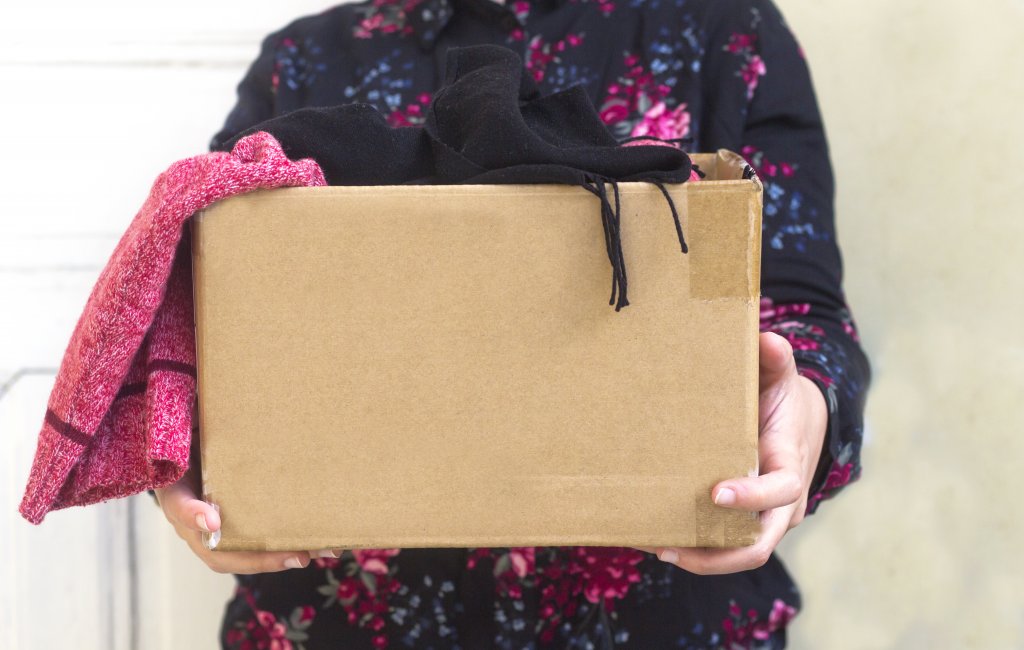So you’ve decluttered your home and now you’re left with boxes and bags full of unwanted items. So what do you do with them? Here are the best ways to dispose of your clutter.

Best Ways to Dispose of Your Clutter
So you’ve gone through the process of decluttering your home. You’ve defined what clutter is, you’ve asked yourself the decluttering questions, and have determined that these items no longer have a place in your home.
Now, what do you do? Sometimes not knowing what to do with decluttered items keeps people hanging onto their clutter.
That’s the last thing you want to do because you won’t be able to experience the full benefits of decluttering until the items are out of your home, car, and life.
The following are the best ways to dispose of your clutter. As soon as you are done decluttering an area, take the items you are no longer keeping out of your house.
Decide which options makes the most sense and take care of it immediately. Just say no to procrastination clutter laying around waiting to be disposed of.
1. Recycle & trash
After sorting through your decluttered items, decide which items are ones that can be recycled or that need to go in the garbage. If the item is not resellable or donatable, see if you can recycle it per your city or county’s regulations. If not, then throw it in the trash.
It may not feel good to throw items in the trash knowing it is going to go into a landfill. However, your home shouldn’t be a storage container for garbage either. You can’t undo the purchase at this point.
Let the trash go and work to make more mindful purchasing choices in the future.

2. Sell it
This option is completely optional and isn’t for everyone. If you have no interest in trying to resell your items that you no longer want or use, then skip this one.
If you are frugal and want to try and resell your clutter, be realistic about what your items are worth and give yourself a deadline to sell them.
Just because you spent a lot of money on an item does not mean it is worth anything near that if you are trying to resell it. Do your research and likely lower your expectations.
You’ll have to weigh if it is worth the additional time, effort, and energy it takes to sell your things. When taking all the factors into account, many people decide it isn’t worth slowing down their progress for the amount they’d make.
However, others find it is worth it. There is no right or wrong. Decide what is right for you and give yourself a deadline to have it out of your home. If it’s not sold by then, it’s time to give it away to a friend or donate it.
3. Give it to a friend
The best way to dispose of your clutter is to give it to the end-user. That’s the ideal scenario for responsibly donating your unwanted items.
If you’ve decluttered your wardrobe, see if you can find friends who can make good use of the clothes that don’t work for you. What is no longer of use to you can be a huge blessing to someone else.
If you don’t have friends or family members who want your items, try your local Buy Nothing group, post the items for free online, or post it in groups you are a part of. You may find that you make a new friend in the process of letting go of your unwanted items.
I’ve been the beneficiary of many awesome hand me downs for myself and my kids. I’m frugal to the core and try to not buy new things when possible.
I am intentional with what I own, and also intentional in how I give it away. It’s great to receive but feels even better to give.

4. Donate to a local organization
If you aren’t able to make a personal connection with the end-user or have too many items so it’s time prohibitive, then donate to local groups or organizations.
Not all organizations are created equally. Do your research to make an informed decision so that you can feel good about where your donations go. Ask others in your community where they donate to.
Some places to consider are animal shelters, homeless shelters, women’s shelters, schools, churches, and foster care agencies.
Call the place you want to bring your donations and ask what they do and do not accept. I’ve found that some places have added more rules so it’s best to know in advance. It’s unfortunate when you load the furniture into the car only to find that they won’t take it.
Emotions & letting go
Letting go of decluttered items can stir a range of emotions. There can be second-guessing and conflicted feelings about the best ways to dispose of the items.
When you take the time to think through the options and are intentional with how you dispose of your things, you’ll feel better about letting them go. For sentimental items, in particular, it can be very helpful to find someone who wants and can use the item.
It’s easier to let go when you know your items will get more use elsewhere and that someone else will appreciate them more than you were. There is a feeling of freedom that comes from unburdening yourself from the excess.
As you declutter and remove items that are no longer serving you, you bring more breathing room back into your space. You’ll find that there is much to gain as you learn to let go.

How to stop having as much clutter to dispose of
Decluttering brings up a range of feelings and realizations. As you notice how many purchasing mistakes you’ve made or things you’ve hung onto for far too long, it would be easy to get stuck feeling guilty or regretful.
While it’s fine to feel those things, the best thing you can do is channel those emotions and energy into changing your habits. Choose to shop more intentionally.
Opt to buy fewer things and consider experience-based gifts or clutter-free gifts instead. You are the guardian and gatekeeper of your home. Don’t perpetuate the clutter cycle.
When you’re tired of decluttering and then finding the best ways to dispose of your clutter, choose to stop buying or bringing clutter into your home in the first place. Making different decisions on the outset is the most important change you can make.
Haven’t decluttered yet?
If you aren’t ready to get rid of your clutter yet because you haven’t gone through the decluttering process, figure out which decluttering method will work best for you. If you get overwhelmed with decluttering, focus on taking just one step at a time.
Want to keep up to date with The Simplicity Habit? Fill out the form below to get weekly emails with tips on how to simplify and declutter and you’ll also get the Your Home Decluttered Jumpstart which includes 100 easy items to declutter and 12 high impact areas to declutter in 10 minutes. These worksheets will help jumpstart your decluttering process immediately.


Randomly, homeless/women’s shelters are also handy places (along with food banks/shelves, of course) to donate excess food. My old church gave away boxes of food to the poorer members of the church toward the end of the year every year. That was nice and all, but they often included things like turkey and I was vegan at the time. So, what to do with that big ol’ turkey? I took it to a women’s shelter, along with the box of stuffing. They were quite thankful for it, and I was happy, too! Indeed, ’tis better to give than to receive.
So this is also a good list for when you have an excess of food to “declutter”. 🙂